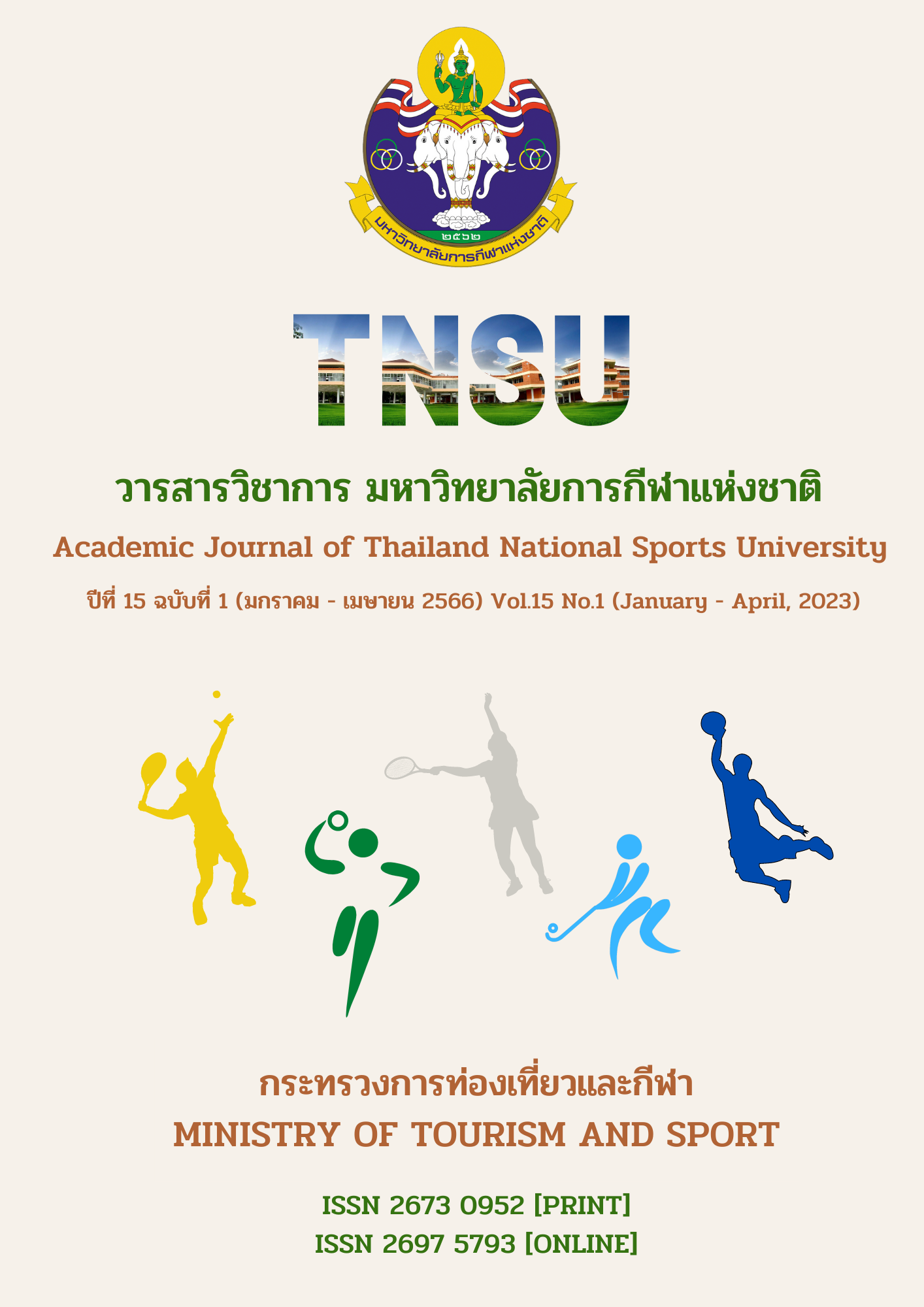PROPOSAL OF THE FACTORS EFFECTING ADMINISTRATIVE ORGANIZATIONAL EXCELLENCE OF SPORTS AUTHORITY OF THAILAND
Main Article Content
Abstract
This academic article is an authoritative analysis aiming to propose the factors effecting organizational excellence from the managerial effectiveness of Sports Authority of Thailand. The conceptual framework was derived from three different components: 1) state enterprise appraisal and evaluation of the high-performance organization, 2) the managing concepts of organizational effectiveness, and 3) smart power utilization. The synthesis results of this study indicated that there were nine factors effectively related to the excellence and managerial effectiveness of Sports Authority of Thailand. The nine different categories are as follows: 1) public policies, 2) leadership, 3) strategies, 4) target segmentation, 5) smart power, 6) organizational culture, 7) operational system, 8) effective organizational management for excellence, and 9) sustainability of organizational products. For the future research recommendations, the confirmation of the factors influencing the organizational excellence from effective administration of Sports Authority of Thailand should have used the statistical analysis in such a way of Structural Equation Model to examine each of the particular factors influencing the organization excellence.
Article Details

This work is licensed under a Creative Commons Attribution-NonCommercial-NoDerivatives 4.0 International License.
The published article is a copyright of the Academic Journal of Thailand National Sports University. The passage appeared in each article in this academic journal is a perspective of each author which is not related to the journal. Each author is required to be responsible for all components of his/her own article. If there are any mistakes, each author must be responsible for those mistakes on his/her own.
References
Andrews, E. (2016). How Ping - Pong diplomacy thawed the cold war. Retrieved from https://www.history.com/news/ping-pong-diplomacy
Attafar, A., Forouzan, B., & Shojaei, M. (2012). Evaluation of organizational excellence based on peters and waterman’s model in Tuka Steel investment holding. American Journal of Scientific Research, 50, 119 - 137.
Buytendijk, F. (2006). The five keys to building a high performance organization. Business Performance Management Magazine, 4(1), 24 - 47.
Cameron, K. (1978). Measuring organizational effectiveness in institutions of higher education. Administrative Science Quarterly, 23(2), 604 - 627.
Cameron, K. & Whetten, D. A. (1983). Organizational Effectiveness: A Comparison of Multiple Models. New York: Academic Press.
Chelladurai, P. (1987). Multidimensionality and multiple perspectives of organizational effectiveness. Journal of Sport Management, 1(1), 37 - 47.
Dittachai Chankuna, Assawin Chanthonsarasom, Kannika Inchana, Thitipong Sukdee, & Nilmanee Sriboon. (2021). Impact of COVID - 19 on sport industry in Thailand. Academic Journal of Thailand National Sports University, 13(2), 263 - 276.
Dittachai Chankuna. (2018). Confirmatory factor analysis of effective fitness centers in Bangkok metropolitan region. Academic Journal of Institute of Physical Education, 10(1), 65 - 76.
Dittachai Chankuna. (2020). Structural equation model of effective fitness centers in Bangkok metropolitan and vicinity region. Academic Journal of Thailand National Sports University, 12(1), 85 - 96.
Ibrahim, A., Hamatineghad, M., Ramezanineghad, R., & Eydi, H. (2013). Designing organizational effectiveness model of selected Iraq’s sport federations based on competing values framework. Sport Management International Journal, 9(1), 69 - 85.
Miller, L. M. (1998). The high - performance organization an assessment of virtues and values prepared for Organizations: The CEO report. San Francisco: Jossey Bass Publisher.
National Institute of Standards and Technology. (2021). How Baldridge Works. Retrieve from https://www.nist.gov/baldrige/how-baldrige-works
Nisada Wedchayanon. (2011). Change in personnel administration in the Thai public sector from 20th century to the beginning of the 21st century. NIDA Development Journal, 51(1), 123 - 155.
Nye, S. J. (1990). Soft power. Foreign Policy, 80, 135 - 171.
Office of the Public Sector Development Commission. (2016). Public sector management quality award. Retrieved from https://www.opdc.go.th/content/Nzc
Peters, T. J. & Waterman, R. H. (1982). In Search of Excellence. New York: Harper and Row.
Quinn, R. E. & Rohrbaugh, J. (1981). A competing values approach to organizational effectiveness. Public Productivity Review, 5(2), 122 - 140.
Quinn, R. E. & Rohrbaugh, J. (1983). A spatial model of effectiveness criteria: Towards a competing values approach to organizational analysis. Management Science, 29(3), 363 - 377.
Sports Authority of Thailand. (2020a). Annual report 2020 Sports Authority of Thailand Ministry of Tourism and Sports. Bangkok: Sports Authority of Thailand.
Sports Authority of Thailand. (2020b). SE - AM SAT 2020 [YouTube]. Retrieved from https://www.youtube.com/watch?v=446JaHWWu8o
State Enterprise Policy Office. (2016a). State enterprise performance appraisal: SEPA. Retrieved from http://sepo.go.th/sepa/contents/1
State Enterprise Policy Office. (2016b). State enterprise assessment model [SE - AM]. Retrieved from http://www.sepo.go.th/pes/contents/38
Waterman, R. H., Peters, T. J., & Phillips, J. R. (1980). Structure is not organization. Business Horizons, 23(3), 14 - 26.


